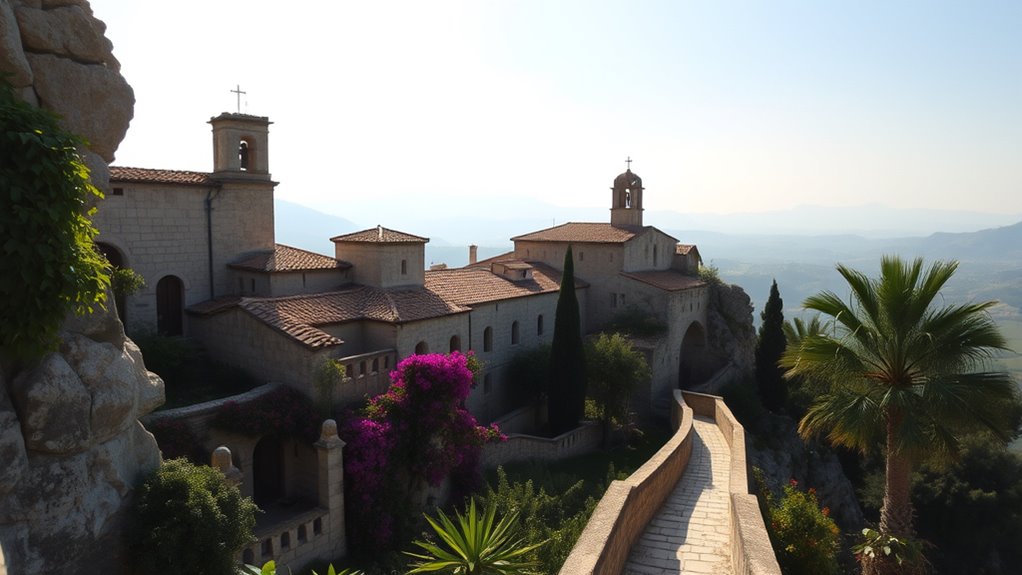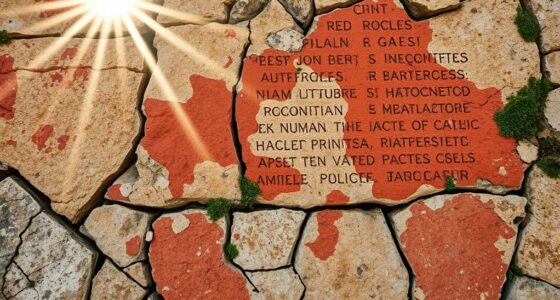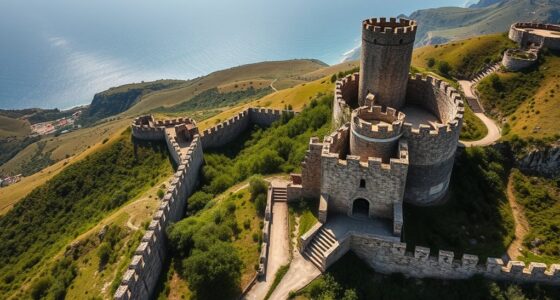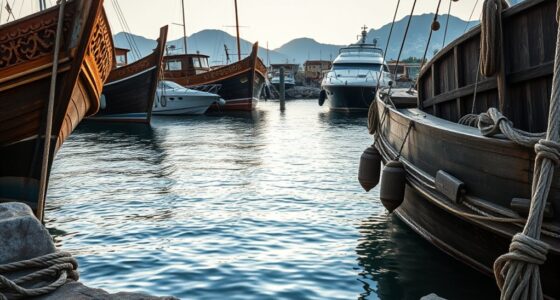Sardinian monasteries offer peaceful retreats rooted in centuries of religious and cultural tradition. You can enjoy serene natural settings—like lush landscapes and water bodies—that foster reflection and spiritual growth. Architecturally rich, these sites feature historic frescoes, simple bell towers, and rustic materials. Today, they combine age-old practices with modern touches, including eco-friendly renovations and cultural festivals. Explore further to discover how these spiritual havens continue to inspire for generations to come.
Key Takeaways
- Sardinian monasteries offer tranquil settings for spiritual retreats, emphasizing connection with nature and historical ambiance.
- Modern retreats integrate traditional practices with activities like yoga, meditation, and eco-friendly accommodations.
- Artistic symbols and frescoes enhance spiritual reflection, blending Byzantine influences with regional styles.
- Preservation efforts focus on sustainable restoration, community involvement, and digital documentation of heritage sites.
- Natural surroundings, including lakes and mountains, play a vital role in fostering peaceful, contemplative retreat experiences.
The Historical Roots of Sardinian Monasteries

The origins of Sardinian monasteries are deeply rooted in the island’s complex prehistoric and historical developments. Sardinia has been inhabited since the end of the Paleolithic era, around 20,000 to 10,000 years ago. The Nuragic civilization, which thrived between the 18th century BC and the 2nd century AD, built about 7,000 nuraghi—mysterious basalt towers that reveal a highly organized society. Over centuries, external influences shaped the island, from Phoenician trade and Carthaginian conquest to Roman rule. Following the fall of Rome, Sardinia fragmented into independent Judicates, fostering local governance and cultural identity. These political and social shifts created fertile ground for religious institutions, which later evolved into the monasteries that became pivotal in Sardinia’s spiritual and community life. Understanding the Nuragic civilization offers insight into the early societal structures that influenced subsequent religious development on the island.
Architectural Marvels and Design Elements
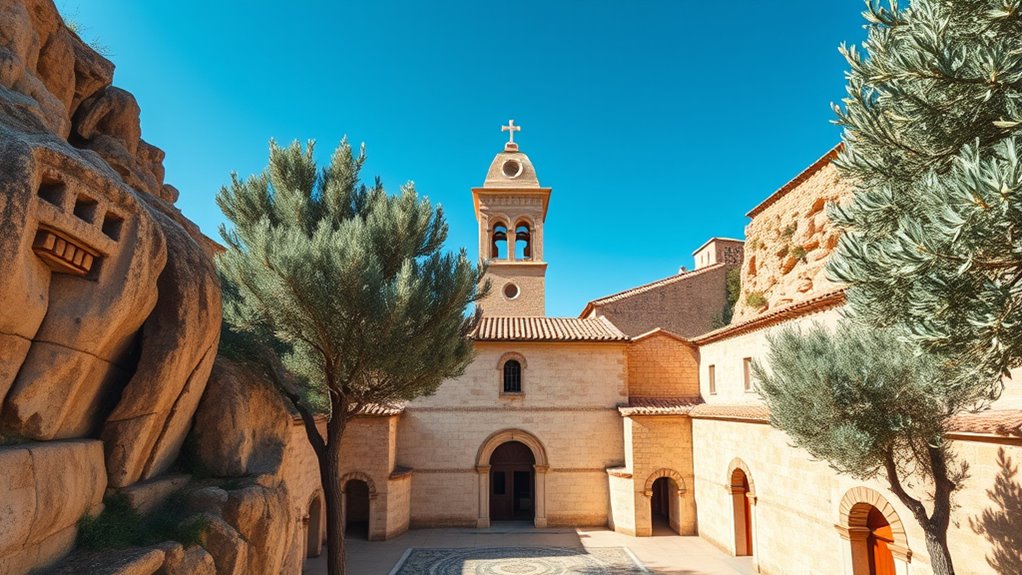
- Bicolour façades with alternating stones highlight the regional craftsmanship and add visual interest to the monasteries.
- Romanesque thick walls and wooden supports provide stability and a sense of permanence to the structures.
- Ceramic basins as decoration and function showcase traditional craftsmanship and utility within the monastic environment.
- Bell towers with simple, integrated design serve as both a visual focal point and a functional element for calling monks to prayer.
- Incorporating rustic materials in construction enhances the authentic medieval aesthetic and reflects the natural landscape of Sardinia.
Serene Natural Settings and Their Significance
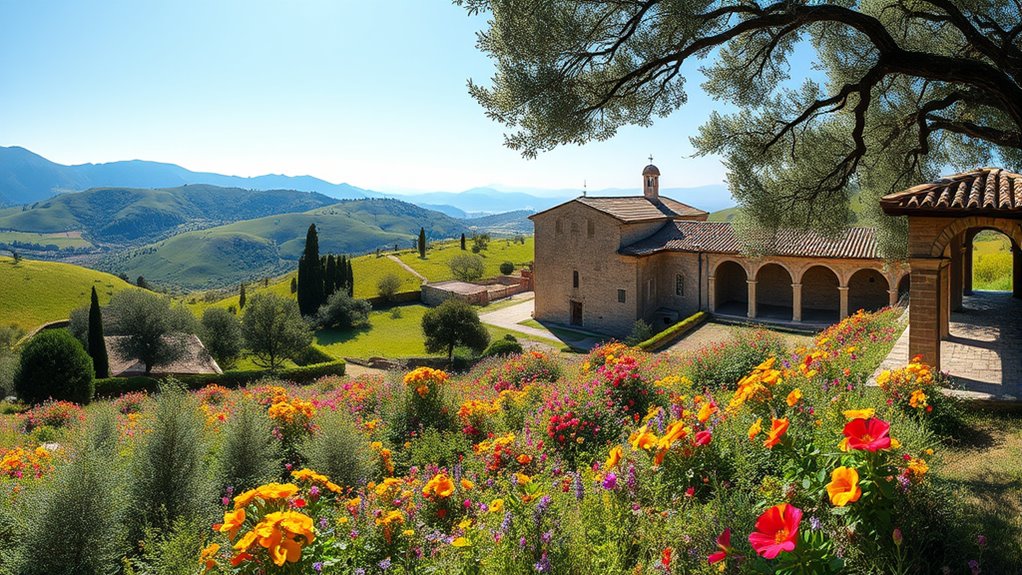
You’ll notice that many Sardinian monasteries are tucked away in quiet, elevated spots, surrounded by natural water bodies and lush landscapes. These serene settings create the perfect environment for reflection and spiritual calm, free from everyday distractions. By being close to nature, they foster peaceful retreats that nurture meditation, prayer, and connection with the environment. Natural sites like Mount Limbara further enhance these retreats by providing inspiring scenery that encourages contemplation and inner peace. Additionally, these locations often feature sustainable architecture that harmonizes with their natural surroundings, amplifying the sense of tranquility and respect for nature.
Tranquil Landscapes for Reflection
Serene natural settings in Sardinian monasteries provide essential spaces for reflection and spiritual renewal. These landscapes foster a sense of peace, helping you disconnect and focus inward. Consider these remarkable environments: 1. The hills around Luogosanto, where rural churches and hermitages offer secluded spots for prayer, with nearby Liscia Lake providing tranquil waters for meditation. These areas often feature natural tranquility that enhances meditative practices. 2. The volcanic relief of Acquafredda, with castle ruins overlooking the biodiverse valley, inviting contemplative walks amid ancient geological formations. The volcanic origins of sites like Acquafredda add a profound sense of connection to the Earth’s ancient energies rich in biodiversity. 3. The plateau of San Pietro di Sorres, offering expansive views and quietude, enhanced by surrounding lakes that deepen your sense of calm. 4. Sacred Well of Santa Cristina, where archaeological and natural elements align to inspire reflection on cosmic cycles during quiet visits.
Nature’s Role in Spiritual Calm
Natural settings play a crucial role in fostering spiritual calm by providing peaceful environments that soothe the mind and soul. Positive natural scenes lift your spiritual feelings more than threatening ones, encouraging self-transcendence and shifting your perception of time. Even adverse experiences like natural disasters can temporarily heighten spiritual awareness. When you’re in nature, your emotional tone influences your spiritual response—calm environments boost your connection, while threatening ones may hinder it. Higher dispositional spirituality makes you more receptive to nature’s spiritual effects. Additionally, understanding regional divorce statistics can influence perceptions of stability and peace in one’s environment, indirectly affecting spiritual well-being.
Experiencing Spirituality: Retreat Practices and Traditions
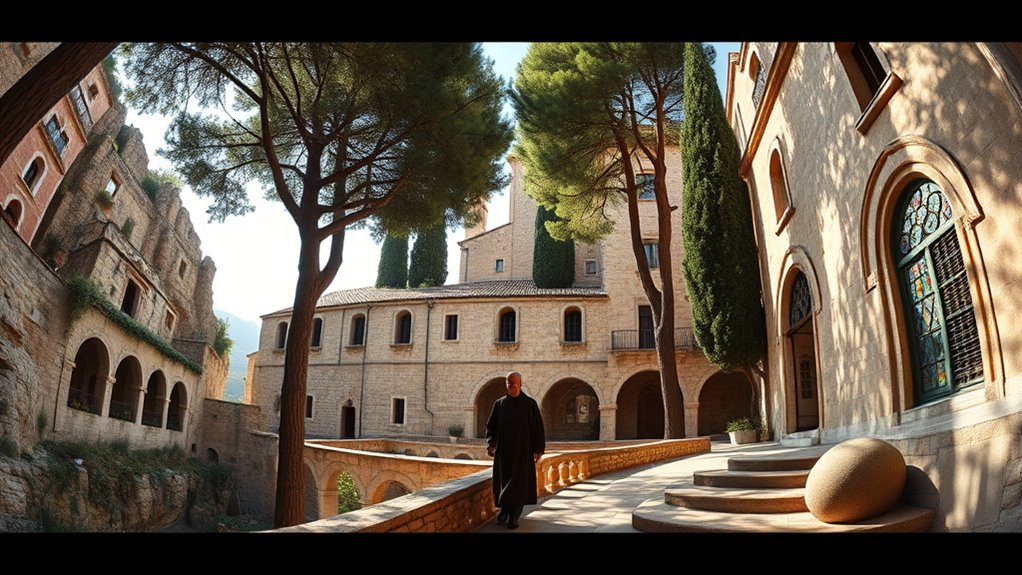
Experiencing spirituality in Sardinia often involves participating in traditional retreat practices that blend prayer, meditation, and connection with nature. You may engage in Benedictine routines emphasizing prayer, work, and spiritual guidance, often joining communal liturgical activities. The Benedictine way balances manual labor with reflection, fostering silence, contemplation, and inner listening. Additionally, in Luogosanto’s hermitages, you’ll find quiet spaces for meditative solitude, surrounded by natural elements like Liscia Lake and olive groves that support silent reflection and walking meditations. Modern retreats incorporate somatic practices such as yoga, body awareness, and guided journaling, integrating nature immersion. These programs typically include:
- Daily prayer, meditation, and spiritual study
- Silence and contemplative practices
- Nature walks and meditation in scenic settings
- Holistic activities like yoga and body awareness
Furthermore, some retreats utilize specialized equipment such as prayer beads or meditation cushions to enhance focus and comfort during practice.
Preservation and Modern Adaptations

You can see that Sardinian monasteries benefit from ongoing preservation efforts and sustainable restoration practices that keep their history alive. Local communities and international organizations work together to protect these sites for future generations. By embracing modern techniques, they make certain these cultural treasures remain intact and accessible today. These initiatives often include archaeological research and community engagement programs that foster a deeper appreciation for Sardinian heritage. Additionally, incorporating spiritual significance into restoration projects helps preserve the monasteries’ cultural and spiritual essence for visitors and future generations.
Historical Preservation Efforts
Efforts to preserve Sardinian monasteries are guided by a robust institutional framework that combines legal protections with modern conservation techniques. You benefit from a system where the Italian Ministry of Cultural Heritage oversees preservation, ensuring sites are protected under national laws and often recognized as UNESCO World Heritage. This framework prioritizes preventive conservation, minimizing damage before active restoration. You’ll find that multiple institutions—including universities and conservation centers—collaborate closely, adopting multidisciplinary approaches. Key activities include:
- Documenting and researching archaeological findings to guide restorations.
- Using digital tools like 3D scanning for precise structural assessments.
- Preserving original building materials and employing careful conservation methods.
- Engaging local communities through educational programs to foster ongoing support and awareness.
Additionally, encryption solutions are increasingly employed to protect sensitive digital records associated with preservation efforts, ensuring data security and integrity in the digital age.
These efforts safeguard Sardinian monasteries’ historical integrity while adapting to modern needs.
Sustainable Restoration Practices
Sustainable restoration practices in Sardinian monasteries focus on blending traditional techniques with modern eco-friendly technologies to preserve their historic integrity while reducing environmental impact. You’ll notice that restorers prioritize reusing original materials like locally sourced stone, timber, and lime-based mortars to maintain authenticity and lower carbon footprints. Revival of dry stone masonry minimizes chemical adhesives and supports breathability of walls. Modern green tech, such as discreet solar panels and rainwater harvesting systems, integrates seamlessly to boost energy efficiency and water independence without compromising architecture. Adaptive reuse transforms spaces for retreats and community events, all while respecting heritage. Accessibility improvements are added thoughtfully, and site management emphasizes native plants and erosion control. These practices ensure Sardinian monasteries remain sustainable, functional, and true to their spiritual and historical roots. Incorporating building techniques that enhance durability and longevity is also essential for long-term preservation efforts.
Cultural Heritage and Religious Celebrations
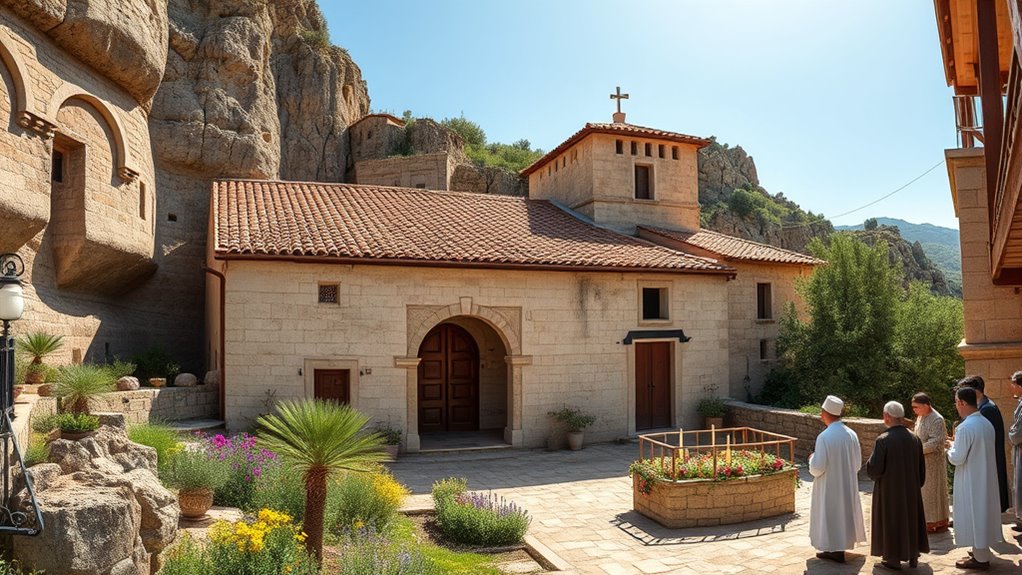
Sardinian religious celebrations are vibrant expressions of the island’s rich cultural heritage, blending spiritual rituals with communal traditions that have endured for centuries. These festivals serve as living links to ancient customs and local identity. You’ll witness:
- Colorful processions like the Sant’Efisio festival (May 1–4), where thousands walk barefoot or in penitential garments from Cagliari to Nora.
- Pilgrimages such as the Feast of Saint Francis of Lula, involving rituals of penitence and gratitude at sacred sites.
- Communal feasts featuring traditional dishes like *su filindeu* and *su zurrette*, fostering social bonds.
- Cultural activities like folk singing, poetry, and dancing that extend celebrations beyond spiritual rites.
- Many of these celebrations are tied to specific religious holidays, which help to preserve traditional practices and strengthen community ties across Sardinia. These events often incorporate cultural heritage elements that highlight Sardinia’s unique history and identity.
Engaging With Art, Frescoes, and Sacred Symbols
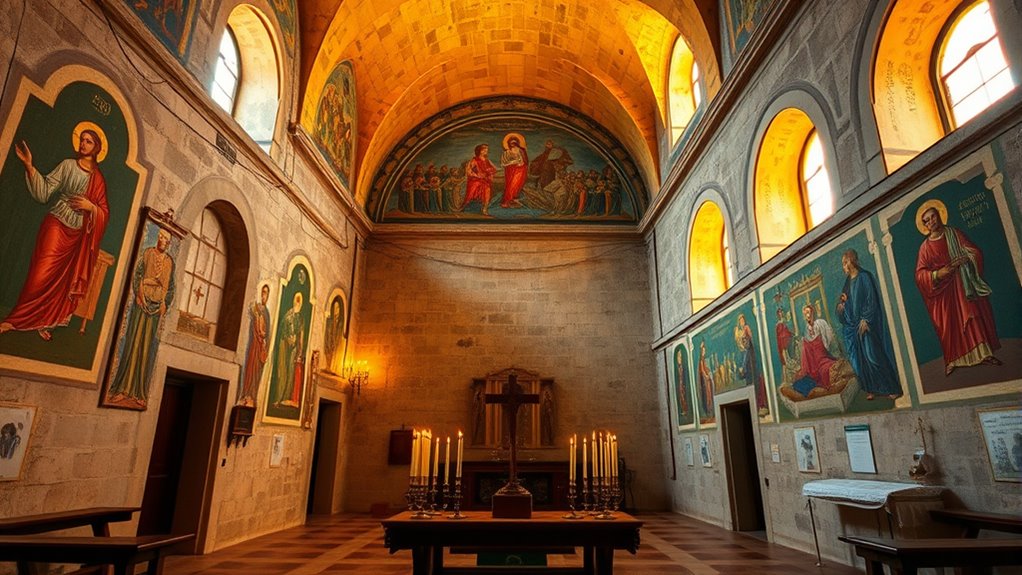
The frescoes inside Sardinian monasteries serve as powerful visual tools that deepen your spiritual engagement. These vibrant artworks use vivid colors, like the blue backgrounds of twelfth-century frescoes, to unify scenes. You notice elongated figures with elegant lines expressing emotions, adding rhythmic movement. Sacred symbols, such as Christ’s miracles and Virgin Dormition, are strategically placed to guide your reflection. These frescoes reflect influences from major centers like Constantinople, blending regional styles with traditional themes.
| Theme | Sacred Symbols | Artistic Style |
|---|---|---|
| Christ’s Miracles | Virgin Dormition | Elongated, expressive figures |
| Major Church Festivals | Sacred motifs in vaults | Vivid colors, natural landscapes |
| Passion of Christ | Iconography above entrances | Byzantine-like technique |
| Divine Intervention | Miracles and festivals | Rhythmic composition |
| Spiritual Reflection | Symbolic placement | High painterly sophistication |
Connecting Past and Present: The Future of Sardinian Spiritual Retreats

As interest in combining spirituality with travel grows, the future of Sardinian spiritual retreats depends on balancing tradition with innovation. You can expect retreats to honor their rich history—like Byzantine and Romanesque influences—while embracing modern practices. To stay relevant, they’ll:
- Incorporate sustainable methods, such as eco-friendly accommodations and local sourcing.
- Use technology, like meditation apps and virtual workshops, to enhance experiences.
- Foster interfaith dialogue, promoting understanding among diverse beliefs.
- Engage local communities actively, preserving cultural authenticity and relevance.
Overall tourism trends in Sardinia 2024 show a +27.9% growth, indicating a rising interest in authentic and meaningful travel experiences that blend tradition with contemporary needs.
Frequently Asked Questions
Are Overnight Stays in Sardinian Monasteries Available for Visitors?
Yes, you can stay overnight in Sardinian monasteries. Many offer guest houses and authentic B&B rooms that you can book online, often starting from around €41–€72 per night. These stays provide a unique experience, combining cultural immersion, peaceful surroundings, and spiritual ambiance. You’ll enjoy amenities like gardens, traditional Sardinian dishes, and quiet spaces for reflection. Just remember to book in advance, as availability can be limited, especially during peak seasons.
Do Retreats Include Guided Meditation or Spiritual Counseling Sessions?
Oh, surely, retreats are just about soaking up the scenery, right? Not quite. You’ll likely find guided meditation and spiritual counseling woven into the experience, especially in organized retreats. These sessions help deepen your reflection, often led by experienced instructors or spiritual guides. Whether in monasteries or natural hermitages, you’re encouraged to explore your inner self, making the retreat both a scenic and soul-searching journey.
How Accessible Are These Monasteries for Individuals With Mobility Challenges?
You might wonder how accessible these monasteries are if you have mobility challenges. Many sites offer some features like entrance ramps, wheelchair-accessible toilets, and close parking spots. However, uneven stone paths, narrow streets, and steep climbs can pose difficulties. Assistance is often available, but you’ll need to plan ahead and check specific facilities. Overall, some monasteries are accessible with effort, while others may require extra support or alternative arrangements.
Are There Specific Times of Year Best for Visiting Sardinian Monasteries?
Coincidentally, the best times to visit Sardinian monasteries align with mild weather and fewer crowds. You’ll enjoy spring (April–June) and fall (September–October), when temperatures are comfortable, and the scenery blooms or turns golden. These months also offer open access and tranquil atmospheres perfect for reflection. Summer can be too hot and crowded, while winter offers solitude but limited services. Plan during shoulder seasons for a peaceful, enriching experience.
Can Visitors Participate in Traditional Religious Ceremonies or Festivals?
You can participate in many traditional Sardinian religious ceremonies and festivals, especially during major celebrations like Saint Francis of Lula or Holy Week. Join processions, watch rituals, or partake in community meals and dances. Respect local customs by dressing modestly and following guidance during processions. While some ceremonies are open to visitors, others may be more private, so it’s best to observe and ask locals about participation opportunities.
Conclusion
Visiting Sardinian monasteries is like stepping into a living tapestry woven with history, spirituality, and art. These retreats aren’t just quiet spots; they’re gateways to inner peace, where every stone and fresco tells a story. As you explore their serene settings and sacred traditions, you’ll feel connected to centuries of devotion. Embrace this timeless journey, and let these spiritual havens be your guiding stars in a world craving meaning and calm.
